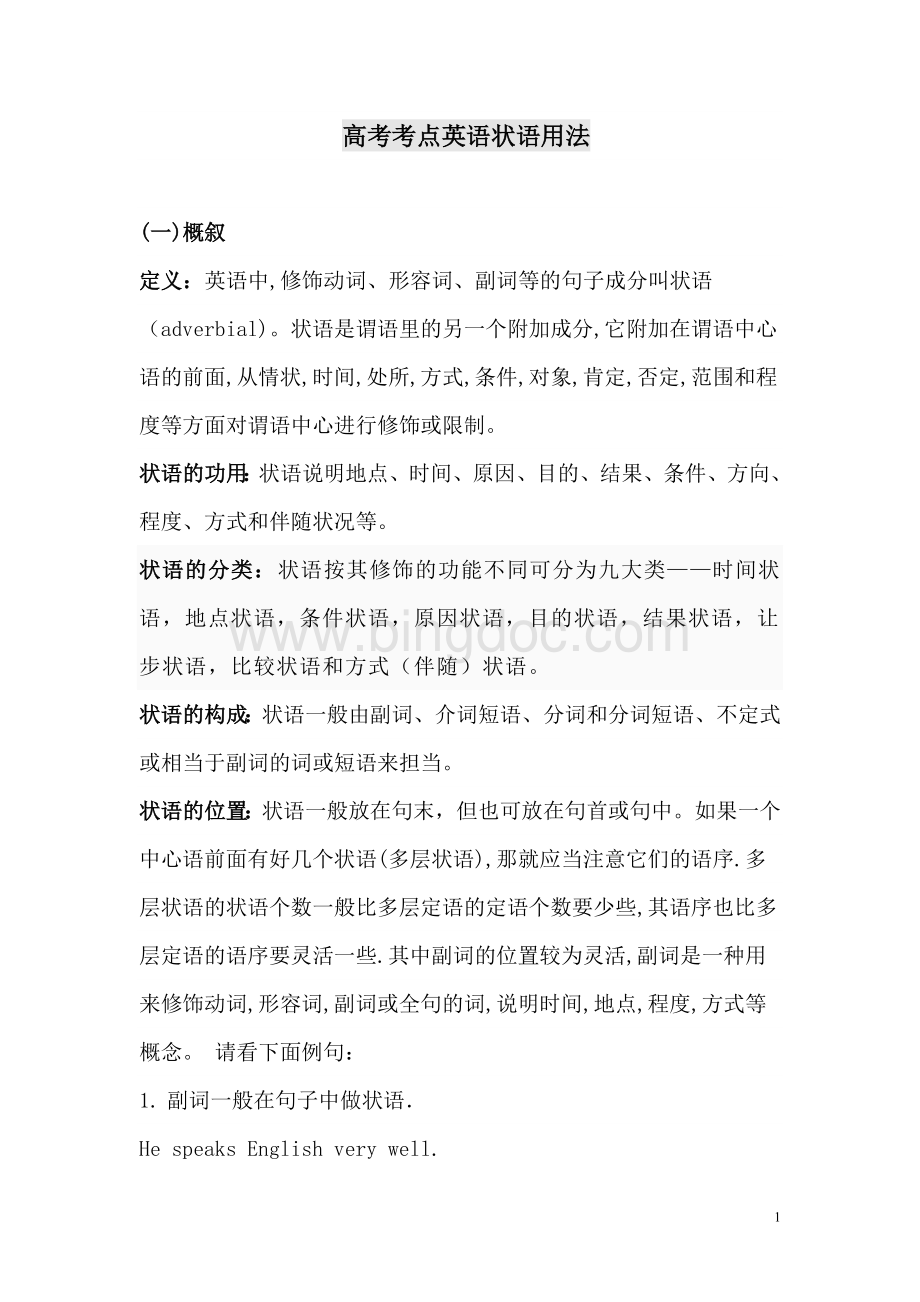英语状语用法精讲Word格式.doc
《英语状语用法精讲Word格式.doc》由会员分享,可在线阅读,更多相关《英语状语用法精讲Word格式.doc(21页珍藏版)》请在冰点文库上搜索。

5.分词作状语
Havinghadaquarrelwithhiswife,helefthomeinabadtemper。
(现在分词)
Seenfromadistance,thefarmhouselookeddeserted.(过去分词)
另外要注意英语一般状语和句首状语的区别,状语在句子中有两种位置:
一种是在主语之后,谓语中心之前,这是状语的一般位置;
另一种是放在主语的前面的,这是状语的特殊位置,这种状语可称"
句首状语"
。
(二)详细讲解
(1)状语从句的分类及其连接词的选择
状语从句(AdverbialClause):
状语从句指句子用作状语时,起副词作用的句子。
状语从句主要用来修饰主句或主句的谓语,它可以修饰谓语、非谓语动词、定语、状语或整个句子。
根据其作用可分为九大类,分别表示时间、地点、原因、目的、结果、条件、让步、比较和方式。
状语从句一般由连词(从属连词)引导,也可以由词组引起。
从句位于句首或句中时通常用逗号与主句隔开,位于句尾时可以不用逗号隔开。
状语的位置比较灵活,可以位于句首、句末或句中。
enough用作状语修饰形容词和副词时必须后置。
状语从句的时态特点:
一般情况下,时间和条件状语从句的谓语动词一般用“一般现在时”表示“一般将来时”,用“现在完成时”表示“将来完成时”。
AssoonasIhavefinishedthiswork,Iwillgohome.
Ifhecomesback,pleaseletmeknow.
状语从句的关键是要掌握引导不同状语从句的常用连接词和特殊的连接词即考点。
现分别列举如下:
1.时间状语从句
常用引导词:
when,as,while,assoonas,before,after,since,till,until.
特殊引导词:
theminute,themoment,thesecond,everytime,theday,theinstant,immediately,directly,nosooner…than,hardly…when,scarcely…when.
EverytimeIlistentoyouradvice,Igetintotrouble.
2.地点状语从句(adverbialclauseofplace)
where
wherever,anywhere,everywhere.
Generally,airwillbeheavilypollutedwheretherearefactories.
Whereveryougo,youshouldworkhard.
地点状语从句一般由连接副词where,wherever等引导,已经形成了固定的句型句型1:
Where+地点从句,(there)+主句。
【注意】此句型通常译成“哪里……哪里就……”;
主句在从句后面时,there可用可不用;
如果主句在从句的前面时,一般都不用there。
Youshouldhaveputthebookwhereyoufoundit.
WheretheCommunistPartyofChinagoes,therethepeopleareliberated.
句型2:
Anywhere/wherever+地点从句,+主句。
【注意】anywhere本身是个副词,但是,常可以引导从句,相当于连词,意思相似于wherever,anywhere引导的从句可位于主句之前,也可以位于主句之后。
而wherever本身就是个连词,表示“在何处,无论何处”。
Wherevertheseais,youwillfindseamen.
3.原因状语从句
because,since,as,for.
seeingthat,nowthat,inthat,consideringthat,giventhat.
Thehigherincometaxisharmfulinthatitmaydiscouragepeoplefromtryingtoearnmore.
4.目的状语从句
sothat,inorderthat.
lest,incase,forfearthat,inthehopethat,forthepurposethat,totheendthat.
Theteacherraisedhisvoiceonpurposethat∕forthepurposethatthestudentsinthebackcouldhearmoreclearly.
5.结果状语从句
so…that,such…that,
suchthat,tothedegreethat,totheextentthat,tosuchadegreethat.
Tosuchadegreewasheexcitedthathecouldn’tsleeplastnight.
6.条件状语从句
if,unless.
as/solongas,onlyif,providing/providedthat,supposingthat,incasethat,onconditionthat.
Providedthatthereisnoopposition,weshallholdthemeetinghere.
7.让步状语从句
though,although,evenif,eventhough.
as(用在让步状语从句中必须要倒装),while(一般用在句首),nomatter…,inspiteofthefactthat,while,whatever,whoever,wherever,whenever,however,whichever.
MuchasIrespecthim,Ican’tagreetohisproposal.
8.比较状语从句
as(同级比较),than(不同程度的比较).
themore…themore…;
justas…,so…;
AistoBwhat/asXistoY;
no…morethan;
notAsomuchasB.
Foodistomenwhatoilistomachine.
9.方式状语从句
as,asif,how.
theway.
Sometimesweteachourchildrenthewayourparentshavetaughtus.
10.状语从句的简化
状语从句同时具备下列两个条件:
①主句和从句的主语一致,或从句主语为it;
②从句主要动词是be的某种形式。
从句中的主语和be动词常可省略。
When(themuseumis)completed,themuseumwillbeopentothepublicnextyear.
另外,比较状语从句经常省略。
Thehigherthetemperature(is),thegreaterthepressure(is).
就状语从句而言,有时为了使语言言简意赅,常常将状语从句进行"
简化"
状语从句的"
现象在口语中较为普遍,而且在高考中的复现率也较高。
因此,有必要对其进行全面、透彻的了解。
状语从句的"
现象常存在于以下五种状语从句中:
①由if,unless等引导的条件状语从句;
②由although,though,evenif/though等引导的让步状语从句;
③由when,while,as,before,after,until/till等引导的时间状语从句;
④由as,asif等引导的方式状语从句;
⑤由as,than等引导的比较状语从句。
下面针对这五种情形作一归纳。
(1)当状语从句的主语是it,且谓语动词是be时,it和be要完全简化掉。
If(itis)possible,hewillhelpyououtofthedifficulty.
(2)当状语从句的主语和主句的主语一致时,从句可以将主语和be动词简化掉。
常用于以下几种情形:
a.连词+形容词
Workhardwhen(youare)young,oryou'
llregret.
b.连词+名词
While(hewas)ayoungboy,hewasalwaysreadytohelpothers.
c.连词+现在分词
As(shewas)walkingalongtheriverbank,shewassingingapopsong.
d.连词+过去分词
Hewon'
tgotherewithusunless(heis)invited.
e.连词+不定式
Hestoodupasif(hewere)tosaysomething.
f.连词+介词短语
Shelookedanxiousasthough(shewas)introuble.
注意:
当从句主语和主句主语不一致时,从句部分要么用完全形式,要么用独立主格结构来表达。
Whenthemeetingwasover,allthepeoplewentoutofthemeeting-room.(=Themeetingover,…)
(2)非谓语动词作状语用法
作状语用的非谓语动词都具有副词的特征。
一般来说,三者都可以改写为与其意思相当的状语从句。
1.不定式作状语时,可以表示目的、原因、结果和条件等。
(1)表示目的。
Shestooduptobeseenbetter.(=…sothatshecouldbeseenbetter.)
注:
如果不定式的逻辑主语与句子的主语不同,则需要用for将不定式的逻辑主语引出,置于不定式之前。
Thehostessopenedthedoorforthegueststocomein.
如果强调目的状语,也可用inordertobeseenbetter,soastobeseenbetter来代替前面例句中的tobeseenbetter。
Heleftearlysoasnottomissthefirstbus.
(2)表示结果。
Heopenedthedooronlytofindtwostrangers.(=…sothathefoundtwostrangers.)
(3)表示原因。
I'
mdelightedtoknowthatyouhavefoundagoodjob.(=asIknowthatyouhavefoundagoodjob…)
不定式表示原因时,通常与lucky,delighted,surprised或glad等表示喜、怒、哀、乐的形容词连用。
(4)表示条件。
Heisveryhardtogetonwith.
2.-ing分词作状语时,可以表示时间、原因、条件、让步、结果、方式或伴随状况,对句子中的谓语动词加以修饰或说明。
(1)表示时间
A.-ing分词表示的动作与句子谓语动词所表示的动作同时或紧接着发生时,用-ing分词的一般式。
Climbingtothetopofthetower(=Whenweclimbedtothetopofthetower),wesawabeautifulview.
有时为了强调时间概念,可把连词when或while放在-ing分词之前。
Whenrushingoutoftheroom,(=Whenherushedoutoftheroom)theboywasknockeddownbyacar.
B.-ing分词表示的动作发生在句子谓语动词所表示的动作之前时,用-ing分词的完成式。
Havingdonehishomework,(=Afterhehaddonehishomework)theboywentouttoplaywithotherboys.
(2)表示原因。
Havingbeentheremanytimes(=Ashehadbeentheremanytimes),heofferedtointroducethecountry.
(3)表示条件。
Notworkinghard(=Ifyoudon'
tworkhard),youwon'
tpasstheexamination.
(4)表示让步。
Havingmuchmoney(=Thoughhehasmuchmoney),hefeelslonely.
(5)表示结果。
Herhusbanddied,leavingherwithfivechildren.(=…sothatheleftherwithfivechildren)
说明:
-ing分词(短语)作状语时,其前常有so,thus等表示结果意义的词。
(6)表示伴随状况和行为方式。
Hecametomyhouse,askingforhelp.(=…andaskedforhelp)
用-ing分词(短语)作状语时必须注意两点:
1.-ing分词(短语)的逻辑主语必须是句子的主语。
2.若-ing分词(短语)所表示的动作与句子中谓语动词所表示的动作同时或紧接着发生,则用-ing分词的一般式;
若发生在谓语动词所表示的动作之前,则用-ing分词的完成式。
3.-ed分词(过去分词)作状语时,可以表示时间、原因、条件、让步和伴随状况,对句子中谓语动词加以修饰或说明。
(1)表示时间。
Seenfromthetopofthehill(=Whenitisseenfromthetopofthehill),ourcitylooksverybeautiful.
(1)为了强调时间概念,有时可把意义相当的连词放在-ed分词短语之前,如上句可改写成:
Whenseenfromthetopofthehill,ourcitylooksverybeautiful.
(2)-ed分词短语的位置不一定都置于句首,有时也可置于句中或句末。
Thedictionary,oncepublished,willbeverypopular.
Greatlymovedbytheteacher'
swords(=Ashewasgreatlymovedbytheteacher'
swords),theboyhelpedotherstudentsfromthenon.
Comparedwithyourprogress(=Ifmyprogressiscomparedwithyours),mineisnothing.
Treatedbadly(=Thoughhewastreatedbadly),theservantstillworkedforhisowner.
(5)表示伴随状况和行为方式。
Hecameback,extremelyexhausted.(=…andhewasextremelyexhausted)
-ed分词短语作伴随状语时,没有状语从句与之相对应,但可以将这种状语改写成“and+分句”。
总结:
从意义上看,不定式短语、-ing分词短语和-ed分词短语的逻辑主语都是句子的主语。
从时态、语态上看,不定式和-ing分词短语有一般式、完成式、主动式和被动式,而-ed分词短语却只有一种形式。
(3)形容词作状语
英语形容词或形容词短语在句中最常见的用法是作定语、表语、宾语补足语和主语补足语。
但除此之外,英语形容词以及形容词短语在句中还有一个特殊用法,即作状语,在句中往往可以起到并列分句或状语从句的功能。
形容词作状语用时,在结构上可以是单个形容词,也可以是形容词短语,通常要用逗号将其和句子的其他部分分开;
若单个形容词直接位于动词后面作方式状语,则不需用逗号。
作状语的形容词或短语在句中位置比较灵活,通常位于句子主语前或句子主语后,有时位于句末,单个形容词作方式状语时还可直接位于动词后面。
当形容词或短语位于主语之前或句末时,通常具有较强的强调意义。
作状语的形容词或短语在句中主要用来补充说明句子中的主语、宾语、谓语或整个句子的内容,表示时间、原因、让步、结果、伴随状态或方式状语等。
1.作时间状语
Ripe,theseapplesaresweet.
2.作原因状语
Wearyanddiscouraged,Ididn’tseemabletodoanythingright.
此句相当于:
BecauseIwaswearyanddiscouraged,Ididn’tseemabletodoanythingright.
3.作让步状语
Largeorsmall,allcountriesareequal.
Whethertheyarelargeorsmall,allcountriesareequal.
4.作结果状语
HesatdownbesideChristina,proppinghisfeetupontherailing,feelingthewarmthofthesunagainsthisface,abletorelaxforthefirsttimeindays.
HesatdownbesideChristina,proppinghisfeetupontherailing,feelingthewarmthofthesunagainsthisface,andasaresulthewasabletorelaxforthefirsttimeindays.
5.作伴随性状语
Theystartedtheexperiment,hopefulforsuccess.
Theystartedtheexperimentandtheywerehopefulforsuccess.
6.作方式状语
Thehorsesarerunningwildalloverthefield.
Thehorsesarerunningfastalloverthefieldasiftheyarewild.
形容词或形容词短语在句中作状语时,起到并列分句或状语从句的功能,因此,这种结构通常具有自己的逻辑主语,即句子中的主语。
然而,当这种结构中含有其他的句子成分,其逻辑主语也有可能不是句子的主语,而是句子中的其他名词或代词,通常是句子的宾语。
此外,这种结构的逻辑主语也可能是整个句子。
(4)伴随状语用法
伴随状语定义:
伴随状语是指状语从句的动作伴随主句发生,它的特点是:
它所表达的动作或状态是伴随着句子谓语动词的动作而发生或存在的。
①Hesatinthearmchair,readinganewspaper.他坐在扶手椅里读报。
②Allnightlonghelayawake,thinking